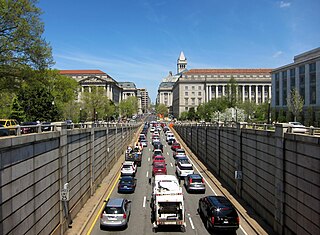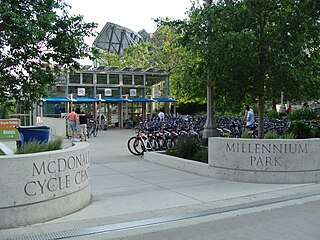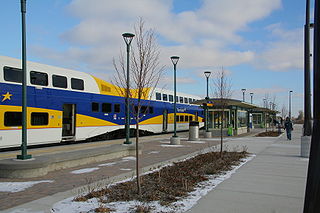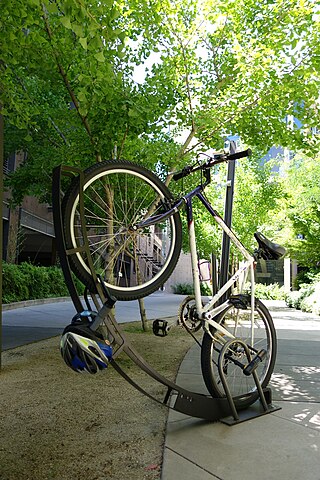Related Research Articles

Palo Alto is a charter city in the northwestern corner of Santa Clara County, California, United States, in the San Francisco Bay Area, named after a coastal redwood tree known as El Palo Alto.

Caltrain is a California commuter rail line serving the San Francisco Peninsula and Santa Clara Valley. The southern terminus is in San Jose at Tamien station with weekday rush hour service running as far as Gilroy. The northern terminus of the line is in San Francisco at 4th and King Street. Caltrain has 28 regular stops, one limited-service weekday-only stop, one weekend-only stop (Broadway), and one football-only stop (Stanford). While average weekday ridership in 2019 exceeded 63,000, impacts of the COVID-19 pandemic have been significant: in August 2022, Caltrain had an average weekday ridership of 18,600 passengers.

AC Transit is an Oakland-based public transit agency serving the western portions of Alameda and Contra Costa counties in the East Bay of the San Francisco Bay Area. AC Transit also operates "Transbay" routes across San Francisco Bay to San Francisco and selected areas in San Mateo and Santa Clara counties. AC Transit is constituted as a special district under California law. It is governed by seven elected members. It is not a part of or under the control of Alameda or Contra Costa counties or any local jurisdictions.

Intermodal passenger transport, also called mixed-mode commuting, involves using two or more modes of transportation in a journey. Mixed-mode commuting is often used to combine the strengths of various transportation options. A major goal of modern intermodal passenger transport is to reduce dependence on the automobile as the major mode of ground transportation and increase use of public transport. To assist the traveller, various intermodal journey planners such as Rome2rio and Google Transit have been devised to help travellers plan and schedule their journey.

People in the San Francisco Bay Area rely on a complex multimodal transportation infrastructure consisting of roads, bridges, highways, rail, tunnels, airports, seaports, and bike and pedestrian paths. The development, maintenance, and operation of these different modes of transportation are overseen by various agencies, including the California Department of Transportation (Caltrans), the Association of Bay Area Governments, San Francisco Municipal Transportation Agency, and the Metropolitan Transportation Commission. These and other organizations collectively manage several interstate highways and state routes, eight passenger rail networks, eight trans-bay bridges, transbay ferry service, local and transbay bus service, three international airports, and an extensive network of roads, tunnels, and bike paths.

The East Bay Electric Lines were a unit of the Southern Pacific Railroad that operated electric interurban-type trains in the East Bay region of the San Francisco Bay Area. Beginning in 1862, the SP and its predecessors operated local steam-drawn ferry-train passenger service in the East Bay on an expanding system of lines, but in 1902 the Key System started a competing system of electric lines and ferries. The SP then drew up plans to expand and electrify its system of lines and this new service began in 1911. The trains served the cities of Berkeley, Albany, Emeryville, Oakland, Alameda, and San Leandro transporting commuters to and from the large Oakland Pier and SP Alameda Pier. A fleet of ferry boats ran between these piers and the docks of the Ferry Building on the San Francisco Embarcadero.

Washington, D.C. has a number of different modes of transportation available for use. Commuters have a major influence on travel patterns, with only 28% of people employed in Washington, D.C. commuting from within the city, whereas 33.5% commute from the nearby Maryland suburbs, 22.7% from Northern Virginia, and the rest from Washington, D.C.'s outlying suburbs.

The station complex of Amtrak's Oakland Coliseum station and Bay Area Rapid Transit (BART)'s Coliseum station is located in the East Oakland area of Oakland, California, United States. The two stations, located about 600 feet (180 m) apart, are connected to each other and to the Oakland Coliseum/Oakland Arena sports complex with an accessible pedestrian bridge.

A bicycle locker or bike box is a locker or box in which up to 2 bicycles can be placed and locked. They are usually provided at places where numerous cyclists need bike parking for extended times, yet where the bikes might otherwise get damaged or stolen.

Bicycle parking is part of the cycling infrastructure of a populated place allowing for the storage of bicycles when they are not being used. Parking facilities for bicycles include racks, lockers, parking stations, and covered areas. Bicycle parking infrastructure, in addition to cyclists' equipment such bicycle locks, offers a degree of security and may prevent bicycle theft. Ad hoc bicycle parking alongside railings, signs, and other street furniture is a common practice and may be recognized through formal legal arrangements.

Downtown Oakland is the central business district of Oakland, California, United States. It is located roughly bounded by both the Oakland Estuary and Interstate 880 on the southwest, Interstate 980 on the northwest, Grand Avenue on the northeast, and Lake Merritt on the east.

Palo Alto station is an intermodal transit center in Palo Alto, California. It is served by Caltrain regional rail service, SamTrans and Santa Clara VTA local bus service, Dumbarton Express regional bus service, the Stanford University Marguerite Shuttle, and several local shuttle services. Palo Alto is the second-busiest Caltrain station after San Francisco, averaging 7,764 weekday boardings by a 2018 count. The Caltrain station has two side platforms serving the two tracks of the Peninsula Subdivision and a nearby bus transfer plaza.

The Leicester Bike Park is a bicycle parking facility in Leicester Town Hall, England. It is managed by the City Council.

McDonald's Cycle Center is an indoor bike station in the northeast corner of Millennium Park in the Loop community area of Chicago, in the U.S. state of Illinois. The city of Chicago built the center at the intersection of East Randolph Street and Columbus Drive, and opened it July 2004. Since June 2006, it has been sponsored by McDonald's and several other partners, including city departments and bicycle advocacy organizations. The bike station, which serves bicycle commuters and utility cyclists, provides lockers, showers, a snack bar with outdoor summer seating, bike repair, bike rental and 300 bicycle parking spaces as of 2004. The Cycle Center is accessible by membership and day pass. It also accommodates runners and inline skaters, and provides space for a Chicago Police Department Bike Patrol Group.

Big Lake station is a Northstar Line commuter rail station in Big Lake, Minnesota, located at 19691 County Road 43, in the southeast corner of Big Lake near U.S. Highway 10. The station features bicycle lockers and a park and ride lot with capacity for 518 vehicles. Commute time to downtown Minneapolis from this station is about 51 minutes.

Bike East Bay, formerly known as East Bay Bicycle Coalition, is a Californian non-profit organization that worked since 1972 toward "promoting bicycling as an everyday means of transportation and recreation" in Alameda and Contra Costa counties of the California's East Bay.

A bicycle parking station, or bicycle garage, is a building or structure designed for use as a bicycle parking facility. Such a facility can be as simple as a lockable bike cage or shed or as complex as a purpose-built multi-level building: the common purpose is that they provide secure bicycle parking. Bicycle parking stations also go by names such as bike stations, bicycle centers and cycle centers, among many others.

Bike Arc LLC, located in downtown Palo Alto, California, is a Silicon Valley startup that designs secure bicycle parking racks and systems. It was founded by Joseph Bellomo and Jeff Selzer in 2008. Jeff Selzer sits on the board of directors of the Silicon Valley Bicycle Coalition and is the General Manager of Palo Alto Bicycles. Joseph Bellomo, a California-licensed architect, is the founder and owner of Joseph Bellomo Architects, Inc. in Palo Alto, which he founded in 1986. In addition to collaborating on Bike Arc, Mr. Bellomo and Mr. Selzer also worked together on the Palo Alto Bikestation at the Caltrain depot.

Hillsboro Intermodal Transit Facility (HITF) is a parking garage with extensive bicycle facilities located in Hillsboro in the U.S. state of Oregon. Located next to Hillsboro Medical Center, the facility has nearly 800 parking spaces, including 13 that have charging stations for electric vehicles, as well as 35 secured spaces for bicycles that include showers and lockers. Opened in 2010, HITF also has 20,000 square feet (1,900 m2) of commercial space, which is mainly used by Portland Community College’s Hillsboro Center. The $16 million facility was a joint project between the city, Pacific University, and Tuality Healthcare.
The Massachusetts Bay Transportation Authority operates subway, bus, commuter rail, and ferry service in the Greater Boston region. Boston has some of the highest rates of non-motorized commuting in the United States, including high bicycle usage. The MBTA offers certain provisions for riders wishing to make part of their trips by bicycle. The agency allows bicycles to be carried on all fixed-route services except the Green Line and the Ashmont-Mattapan High Speed Line light rail lines, although they are restricted on the commuter rail and heavy rail subway services at peak hours. Bicycle storage areas are offered at many stations, with "Pedal and Park" locking bicycle cages at certain high-usage stations.
References
- ↑ Free Wheelin' Archived 2010-01-15 at the Wayback Machine , accessed on January 23, 2010.